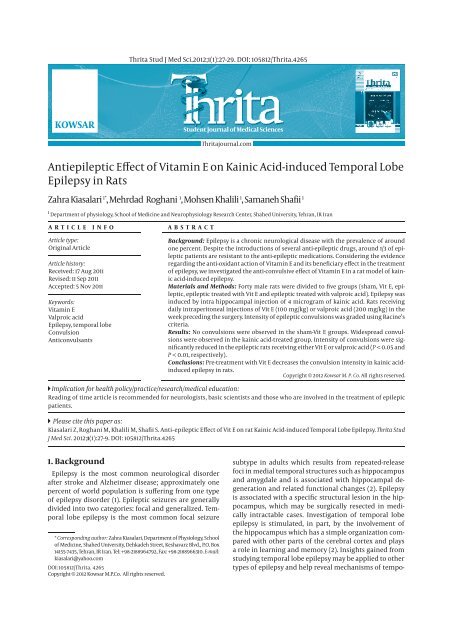by Author Index by Keywords - Index of
by Author Index by Keywords - Index of
by Author Index by Keywords - Index of
Create successful ePaper yourself
Turn your PDF publications into a flip-book with our unique Google optimized e-Paper software.
KOWSAR<br />
Thrita Stud J Med Sci.2012;1(1):27-29. DOI: 105812/Thrita.4265<br />
Student Journal <strong>of</strong> Medical Sciences<br />
Thritajournal.com<br />
Antiepileptic Effect <strong>of</strong> Vitamin E on Kainic Acid-induced Temporal Lobe<br />
Epilepsy in Rats<br />
Zahra Kiasalari 1* , Mehrdad Roghani 1 , Mohsen Khalili 1 , Samaneh Shafii 1<br />
1 Department <strong>of</strong> physiology, School <strong>of</strong> Medicine and Neurophysiology Research Center, Shahed University, Tehran, IR Iran<br />
ARTICLE INFO ABSTRACT<br />
Article type:<br />
Original Article<br />
Article history:<br />
Received: 17 Aug 2011<br />
Revised: 11 Sep 2011<br />
Accepted: 5 Nov 2011<br />
<strong>Keywords</strong>:<br />
Vitamin E<br />
Valproic acid<br />
Epilepsy, temporal lobe<br />
Convulsion<br />
Anticonvulsants<br />
Background: Epilepsy is a chronic neurological disease with the prevalence <strong>of</strong> around<br />
one percent. Despite the introductions <strong>of</strong> several anti-epileptic drugs, around 1/3 <strong>of</strong> epileptic<br />
patients are resistant to the anti-epileptic medications. Considering the evidence<br />
regarding the anti-oxidant action <strong>of</strong> Vitamin E and its beneficiary effect in the treatment<br />
<strong>of</strong> epilepsy, we investigated the anti-convulsive effect <strong>of</strong> Vitamin E in a rat model <strong>of</strong> kainic<br />
acid-induced epilepsy.<br />
Materials and Methods: Forty male rats were divided to five groups (sham, Vit E, epileptic,<br />
epileptic treated with Vit E and epileptic treated with valproic acid). Epilepsy was<br />
induced <strong>by</strong> intra hippocampal injection <strong>of</strong> 4 microgram <strong>of</strong> kainic acid. Rats receiving<br />
daily intraperitoneal injections <strong>of</strong> Vit E (100 mg/kg) or valproic acid (200 mg/kg) in the<br />
week preceding the surgery. Intensity <strong>of</strong> epileptic convulsions was graded using Racine’s<br />
criteria.<br />
Results: No convulsions were observed in the sham-Vit E groups. Widespread convulsions<br />
were observed in the kainic acid-treated group. Intensity <strong>of</strong> convulsions were significantly<br />
reduced in the epileptic rats receiving either Vit E or valproic acid (P < 0.05 and<br />
P < 0.01, respectively).<br />
Conclusions: Pre-treatment with Vit E decreases the convulsion intensity in kainic acidinduced<br />
epilepsy in rats.<br />
Copyright c 2012 Kowsar M. P. Co. All rights reserved.<br />
Implication for health policy/practice/research/medical education:<br />
Reading <strong>of</strong> time article is recommended for neurologists, basic scientists and those who are involved in the treatment <strong>of</strong> epilepic<br />
patients.<br />
Please cite this paper as:<br />
Kiasalari Z, Roghani M, Khalili M, Shafii S. Anti–epileptic Effect <strong>of</strong> Vit E on rat Kainic Acid-induced Temporal Lobe Epilepsy. Thrita Stud<br />
J Med Sci. 2012;1(1):27-9. DOI: 105812/Thrita.4265<br />
1. Background<br />
Epilepsy is the most common neurological disorder<br />
after stroke and Alzheimer disease; approximately one<br />
percent <strong>of</strong> world population is suffering from one type<br />
<strong>of</strong> epilepsy disorder (1). Epileptic seizures are generally<br />
divided into two categories: focal and generalized. Temporal<br />
lobe epilepsy is the most common focal seizure<br />
* Corresponding author: Zahra Kiasalari, Department <strong>of</strong> Physiology, School<br />
<strong>of</strong> Medicine, Shahed University, Dehkadeh Street, Keshavarz Blvd., P.O. Box<br />
14155-7435, Tehran, IR Iran. Tel: +98-2188964792, Fax: +98-2188966310. E-mail:<br />
kiasalari@yahoo.com<br />
DOI: 105812/Thrita. 4265<br />
Copyright c 2012 Kowsar M.P.Co. All rights reserved.<br />
subtype in adults which results from repeated-release<br />
foci in medial temporal structures such as hippocampus<br />
and amygdale and is associated with hippocampal degeneration<br />
and related functional changes (2). Epilepsy<br />
is associated with a specific structural lesion in the hippocampus,<br />
which may be surgically resected in medically<br />
intractable cases. Investigation <strong>of</strong> temporal lobe<br />
epilepsy is stimulated, in part, <strong>by</strong> the involvement <strong>of</strong><br />
the hippocampus which has a simple organization compared<br />
with other parts <strong>of</strong> the cerebral cortex and plays<br />
a role in learning and memory (2). Insights gained from<br />
studying temporal lobe epilepsy may be applied to other<br />
types <strong>of</strong> epilepsy and help reveal mechanisms <strong>of</strong> tempo-


